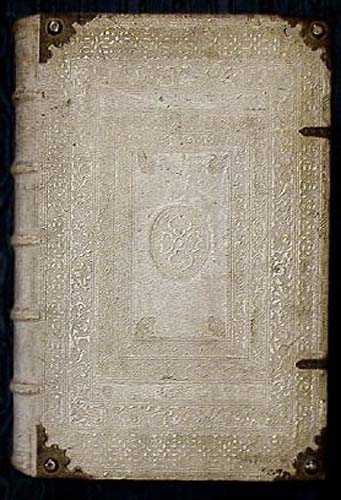

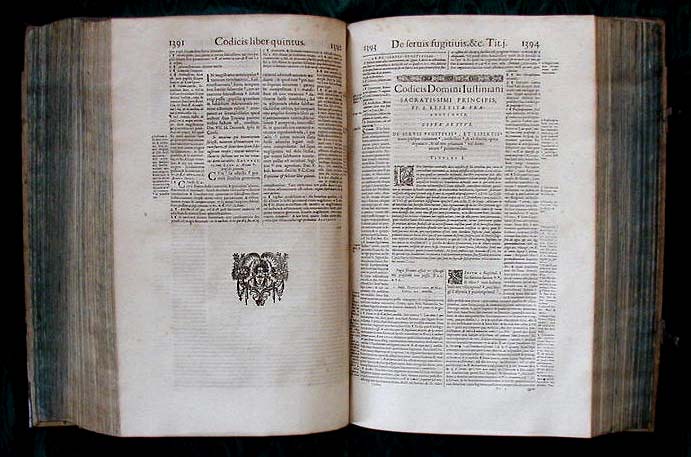
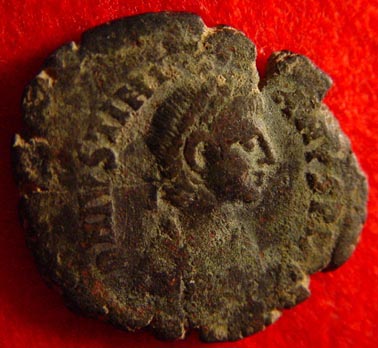
Justinian (c.482-565) Justinian took his education at Constantinople, primarily in Jurisprudence and Philosophy, before returning to the Court and the Military, and it was not until his forty-fourth year that he ascended the throne as Sovereign of the Empire, on 01 August, 527. His reign was perhaps the most far-reaching of the Latter Period Emperors, and was the last to attempt the restoration of the Roman Empire to its earlier stature. The great wars fought under him, and the even greater building and rebuilding of the Empire itself stemmed from his beliefs that the continuation of the Roman Civilisation lay in military superiority, and in Roman Law.
It was Justinian's desire to restore the Empire -- both East and West -- to all of its former glory. In fact, it has been said that his desire to restore the former Roman Empire was an obsession. His greatest accomplishment toward this end was the revision and codification of Roman law. Justinian understood that a strong government could not exist without good laws. Although the Romans prided themselves on their written laws, several centuries of written laws had brought nothing but confusion. In Justinian's day, the laws had grown too numerous and too confusing; a person could spend a lifetime and never master them.
The most enduring work of Justinian was his codification of the laws. This, too, was an important part of his general scheme. The great empire he was reconquering must have the strength of organized unity. He says in the edict of promulgation of his laws that a state rests on arms and law ("De Justin. Cod. Confirmando", printed in front of the codex). The scattered decrees of his predecessors must then be collected in a well-ordered and complete codex, logically arranged, so that every Roman citizen could learn at once the law of the empire on any subject. This codification was Justinian's great work. He made many new laws himself, but his enduring merit is rather the classification of scattered older laws. The legislation that the world owes to Justinian is in outline this:
*First, a commission of ten lawyers (including the famous Tribonianus and Theophilus) reduced the bulky and rambling Theodosian Code (published in 438) to an orderly compendium, inserting into it the laws made since it was written. So the "Codex" was produced in 529.
*Second, a mass of answers given by authorities (the responsa prudentum that formed acknowledged precedents) were arranged (omitting all superfluities) in fifty books, whereby a law library of a hundred and six volumes was reduced to about one-fifth. This is the "Digest", or "Pandects", published in 530.
*Third, a manual of law for students was compiled from the commentaries of Gaius (second century). This, the "Institutes", was published in the same year, 530.
*In 534, finally, the whole work was revised, and a fourth part, the "Authentic", or "Novels", was added, containing later decisions made by Justinian's own courts.
So the immortal "Corpus Juris Civilis" was produced, consisting of four parts: (a) Digestae seu Pondecta, (b) Institutiones, (c) Codex, (d) Authenticum seu Novellae (an excellent account of its composition is found in Bury's Gibbon, ed. Cit., IV 461-510).
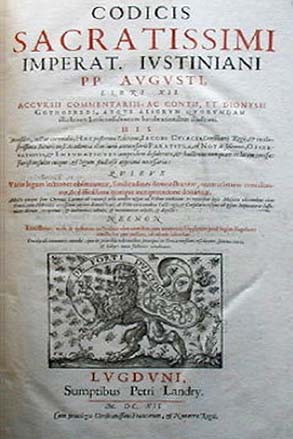
The 1612 Lyon edition represents the third and final revision by Pierre Landry, of the Justinian Code, and this, the fourth volume, representing the Codex Sacra, stands arguably as the second most important printed book in the history of the Christian Churches. The Catholic Encyclopedia (New York; 1907; the Robert Appleton Company, publishers: Volume VIII) states:
"It would be difficult to exaggerate the importance of Justinian's Corpus Juris Civilis. It is the basis of all canon law (ecclesia vivit lege romana), and the basis of civil law in every civilized country."

Description
Authors: Justinian I, Emperor of the East [Flavius Anicius Julianus Justinianus] (483 - 565):
[Edited by Antoine Leconte (1517 - 1586)]
[Glossed by Franciscus Accursius (1182 - 1260)]
[Commentaries by Denis Godefroy (1549 ‚ 1622)]
Title: Codicis Sacratissimi Imperat. Iustiniani Principis;
Printed in: Lugduni [i.e. Lyon]; 1612;
Publisher: Sumptibus Petris Landry (Landry, Pierre, fl. 1573-1602 [printer]);
Physical Details:
Double-Crown (Demy-Elephant) Folio; (27 cm by 39 cm - 11 inches by 15 1/2 inches); [20 leaves, forming 40 pages] 616 leaves, forming 1232 pages; 2464 numbered columns, [41 leaves, forming 82 pages] with front blank, rear blank and integral blanks present, foliated: ¸ - ¸¸ as Folio, in eights; ¸¸¸ as Folio, in four; A - A5 [A6 - A8] continuously as Folio in eights, through [NNnn8]; a complete copy, collating with Saint Bonaventure University Copy, which includes the final blank (as well as both the initial and integral blanks), unlike the only other copy noted in America - the Duke University Copy.
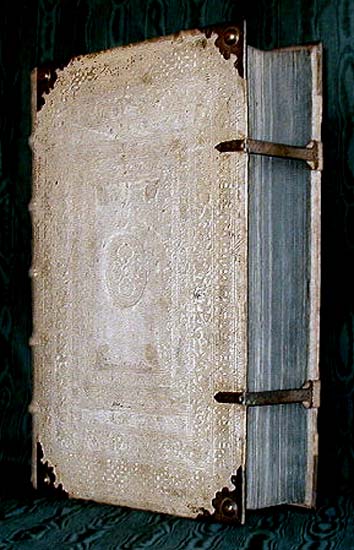
In Very Good antiquarian condition, in contemporary full blind-stamped Vellum over thick beveled wooden boards, with eight intricately etched original brass corner-bosses, and the original hand-decorated brass catches and latches, in perfect working order; sewn on five doubled cords, with the spine raised on five corresponding bands, in six compartments, titled in manuscript to the first and second compartments in a contemporary hand; all edges dyed green; the stamped and rolled panel decoration on both front and rear boards among the most exuberant ever produced by any of the workshops of Wittenburg. Textblock clean, bright and unsullied, without a single marking of previous ownership, this example having spent its 392 year life in the private collection of a single family of Lyon. This enormous independent fourth part of the six-part Juris Civilis comprises the Codex Sacra, or Canon Law, often called the second most importamt book in the history of the Catholic Church. A complete and nearly pristine example of the immensely rare Lyon printing of 1612, in its original binding.
In Latin, in double columns of 88 lines, plus running headlines, column numbers and foliation markings, with marginal glosses and interlineative commentary surrounding the text, in Pierre Landry's brilliantly sharp Upright Roman and Roman Italic fonts, with his "Rampant Lion Sinister" Lyon printer's mark ( publisher's device (11 x 9 cm,lion rampant with banner bearing motto "De Forti Dulcedo"), engraved head and tail-pieces, and historiated initials, with the title leaf printed in black and red. One of the largest undertakings of printing in the history of the Presses of Lyon.
Provenance: from a private European collection.
Copies listed by WorldCat/OCLC: 2: The Saint Bonaventure University Copy, which includes the final blank (as well as both the initial and integral blanks), and which contains the full six volumes, and the Duke University Copy, which contains only the Codex Sacra as offered here, but which lacks the ultimate blank, present in this example.
Copies listed in NUC (pre-1955): 3: NUC adds the copy now held by the Brand Van Zyl Collection of Jus Commune Books at the Law Library of the University of Cape Town, South Africa, which lacks Volume III.
The very few examples of the 1589 and 1612 Folio editions which have reached the marketplace in the last fifty years according to the auction records, have generally been plagued by condition problems, owed to the books' enormous size and weight. Three individual books from the much later 1663 (Amsterdam) reprint of the six volume edition, are currently catalogued by booksellers in New York, Santa Monica California, and London, priced between $2000.00 and $2950.00 per volume - all heavily worn and/or lacking text leaves and blanks.
| see more Chambers's CYCLOPAEDIAS | Go to Paradise Islands |